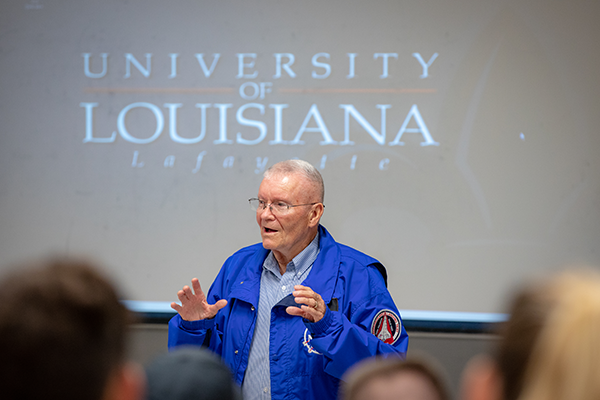Fred Haise Jr. and two other NASA astronauts – Jim Lovell and Jack Swigert – embarked on a 10-day mission to the moon on April 11, 1970, aboard Apollo 13.
The moon landing never happened. The crew’s return to earth – after six days in space – miraculously did.
The astronauts were two and a half days into the trip and more than 200,000 miles away when an oxygen tank exploded.
Haise, 84, said during a talk on the University of Louisiana at Lafayette campus that the crew wasn’t overly concerned initially.
That changed when its members realized the severity of the damage he told about 150 students and faculty members from UL Lafayette’s College of Engineering gathered in a Rougeou Hall Auditorium.
The explosion crippled Apollo 13’s two most critical components: the command module, which housed the astronauts, and the service module, which supplied propulsion and electrical power.
“There was no Plan B for our circumstances. We’d had this explosion that caused major damage, but we were still sitting there,” Haise said.
The astronauts grappled with a range of problems, including loss of power and cabin heat. They were forced to move into the lunar module from the command craft, which was too damaged to safely ferry the astronauts home.
That reduced the odds of getting back to earth.
The lunar module was designed only for landing on the moon, and provided far less propulsion than the command module.
“We were in deep trouble,” said Haise, the mission’s lunar module pilot.
The crew and NASA ground controllers scrambled to devise a plan.
Without enough power to “turn around” and return to earth, a decision was made by NASA to send the craft into orbit around the moon.
The moon’s gravitational pull – coupled with propulsion from the lunar module – slung the craft back toward the earth at just the right angle, Haise explained. “We had to stay at the right speed and the right altitude to maintain a certain orbit and went right on around the moon.”
The strategy was more successful than the astronauts could have hoped for. Apollo 13 splashed into the South Pacific Ocean on April 17, 1970.
It was the second-closest landing to a targeted spot in the history of the Apollo program. The program began in 1961 and ended following the return of Apollo 17 in 1972.
“Only Apollo 10 did better,” said Haise, who retired from NASA in 1979.
The crew was plucked from the ocean near the Samoan Islands by the aircraft carrier Iwo Jima.
A feverish Haise, who had developed a urinary tract infection during the mission, was hustled off to sick bay.
“I missed the cake and ice cream,” he said with a laugh.
In 1995, the story of the mission was chronicled in the movie "Apollo 13," which starred Bill Paxton as Haise, Tom Hanks as Lovell and Kevin Bacon as Swigert.
“Overall I thought it did a very good job,” he said of the film.
Haise did have one major quibble. Despite being provided with transcripts of conversations between ground control and the astronauts, the movie included none “of our lines.” Haise said.
“The only line that was ours was ‘Houston, we’ve had a problem.’ The rest of that movie was Hollywood scriptwriters.”
During a question and answer session following the talk, a student asked Haise if he would ever consider taking a trip to Mars by a private company, a possibility being discussed for the future.
He said no. He is a better pilot than passenger.
“There wouldn’t be much hands on stuff for pilots to do. I’d be looking for something to break,” he said to raucous laughter.
Photo: Apollo 13 astronaut Fred Haise spoke to students from UL Lafayette's College of Engineering on Wednesday. Rachel Keyes/University of Louisiana at Lafayette
